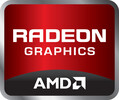Review MSI GX70H-A108972811B Notebook
AMD A10-5750M | AMD Radeon HD 8970M | 17.30" | 3.7 kg

The AMD Radeon HD 8970M is a 28nm DirectX 11 graphics card based on the GCN (Graphics Core Next) architecture. Built primarily for large laptops, the advanced card is positioned near the top of the high-end category as of 2013. Its performance and feature set are similar to the HD 7970M, as the 8970M shares the same core and only features a higher maximum core clock.
The design of the Radeon 8900M series has its roots to the Pitcairn chip as found on the desktop Radeon HD 7870. The 8970M in particular is similar to its desktop Radeon HD 7870 counterpart with 1280 1D shader cores and 80 texture units, but has a core clock of only 900 MHz (boost) versus the 1000 MHz clock of the HD 7870. Compared to the HD 7970M, the 8970M shares the same base clock rate but with a 50 MHz higher Turbo clock for a 6% increase (1.01 TFLOPS vs. 1.07 TFLOPS) in raw SP calculations. As a result, general performance of the HD 8970M is somewhere between the 7850 and 7870 desktop Radeon cards.
When compared to mobile Nvidia GPUs, the HD 8970M performs significantly faster than the GeForce GTX 675M and slightly above the Nvidia GeForce GTX 680M. Therefore, almost all demanding games of 2013 will run fluently on very high details and 1080p resolution.
Features of the 8970M include the new UVD3 video decoder for decoding MPEG-4 AVC/H.264, VC-1, MPEG-2, Flash, Multi-View Codec (MVC) and MPEG-4 part 2 (DivX, xVid) HD videos directly from the AMD GPU.
The 8900M series also supports automatic graphics switching between the integrated GPU and discrete GPU. Called Enduro, the technology supersedes AMD's Dynamic Switchable Graphics and is similar to Nvidia's Optimus. Furthermore, the 8970M can directly support up to 6 connected monitors using Eyefinity Technology if Enduro is disabled.
Other features of the 8900M series include ZeroCore for reducing power consumption when the display is turned off. Power Gating, however, is not supported according to AMD. PowerTune allows automatic overclocking and underclocking of the graphics card as long as the GPU is within its TDP range. For example, the chip may be underclocked when running FurMark and OCCT, but will overclock in certain games like Lost Planet, Crysis or Resident Evil 5.
The integrated HD audio processor is able to transmit HD Audio (TrueHD or DTS Master Audio) over HDMI and DisplayPort (e.g., for Blu-Ray videos). Additionally, it now allows audio to output simultaneously and in parallel to multiple devices with the new Discrete Digital Multipoint Audio (DDMA) feature.
Power consumption of the 8970M is in the same ballpark as the GeForce GTX 680M. The subsequently large heat output suits the 8970M as an option only for large laptops or DTRs (desktop replacements) equipped with relatively powerful cooling solutions.
Radeon HD 8900M Series
| |||||||
| Codename | Neptune | ||||||
| Architecture | GCN | ||||||
| Pipelines | 1280 - unified | ||||||
| Core Speed | 850 - 900 (Boost) MHz | ||||||
| Memory Speed | 4800 MHz | ||||||
| Memory Bus Width | 256 Bit | ||||||
| Memory Type | GDDR5 | ||||||
| Max. Amount of Memory | 4 GB | ||||||
| Shared Memory | no | ||||||
| API | DirectX 11.1, Shader 5.0, OpenGL 4.2 | ||||||
| Power Consumption | 100 Watt | ||||||
| Transistor Count | 2.8 Billion | ||||||
| technology | 28 nm | ||||||
| Features | 2304 GLOPS SP, 144 DP Compute Power, 154 GB/s Memory Bandwidth, 80 TMUs, 32 ROPs, 20 Compute Units (OpenCL 1.2), 212 mm2 Die Size, PCIe 3.0 x16 | ||||||
| Notebook Size | large | ||||||
| Date of Announcement | 15.05.2013 | ||||||
| Link to Manufacturer Page | www.amd.com | ||||||
The following benchmarks stem from our benchmarks of review laptops. The performance depends on the used graphics memory, clock rate, processor, system settings, drivers, and operating systems. So the results don't have to be representative for all laptops with this GPU. For detailed information on the benchmark results, click on the fps number.

























































| low | med. | high | ultra | QHD | 4K | |
|---|---|---|---|---|---|---|
| Watch Dogs 2 | 73.8 | 63.5 | 33 | 20.8 | ||
| Call of Duty Infinite Warfare | 80.5 | 74.5 | 51.6 | 46.1 | ||
| Titanfall 2 | 144 | 139 | 60 | 54 | ||
| Farming Simulator 17 | 190 | 158 | 124 | 54 | ||
| Battlefield 1 | 149.3 | 99.9 | 53.4 | 50.1 | ||
| Mafia 3 | 42.2 | 28.9 | 16.1 | |||
| FIFA 17 | 292.4 | 234.9 | 161.3 | 155.2 | ||
| Deus Ex Mankind Divided | 62.1 | 47.7 | 27.8 | 16.6 | ||
| No Man's Sky | 60.4 | 51.3 | 32.6 | 16.7 | ||
| Mirror's Edge Catalyst | 81.5 | 60.3 | 33.4 | 15 | ||
| Overwatch | 172.3 | 126.6 | 116.3 | 54.2 | ||
| Doom | 74.7 | 69.3 | 42.2 | 40.8 | ||
| Hitman 2016 | 52.4 | 47.8 | 31.4 | 27.3 | ||
| The Division | 82.6 | 54.1 | 29.8 | 24.8 | ||
| Far Cry Primal | 101 | 50 | 44 | 35 | ||
| XCOM 2 | 88.7 | 39.7 | 25.6 | 25 | ||
| Rise of the Tomb Raider | 85 | 54 | 31.9 | 23.4 | ||
| Rainbow Six Siege | 212.7 | 139.6 | 81.3 | 65.1 | ||
| Just Cause 3 | 82.1 | 67.5 | 40.9 | 37 | ||
| Star Wars Battlefront | 87.2 | 71 | 55.8 | 48.2 | ||
| Assassin's Creed Syndicate | 62.9 | 56.9 | 38 | 19.4 | ||
| Fallout 4 | 96.6 | 66.8 | 39 | 30.9 | ||
| Anno 2205 | 106 | 64.9 | 32 | 13.1 | ||
| FIFA 16 | 194.4 | 141.2 | 109.6 | |||
| World of Warships | 166.8 | 145 | 101.7 | 77.6 | ||
| The Witcher 3 | 81.9 | 53.6 | 30.9 | 17.7 | ||
| Dirt Rally | 196 | 124.6 | 82.4 | 49.5 | ||
| GTA V | 138.1 | 127.9 | 55.2 | 23.1 | ||
| Sims 4 | 182.7 | 139 | 102 | 87.2 | ||
| Watch Dogs | 65.4 | 53.5 | 35 | 26.3 | ||
| Wolfenstein: The New Order | 60 | 60 | 57.4 | 46 | ||
| The Elder Scrolls Online | 82.2 | 74.2 | 63.4 | 42.9 | ||
| Titanfall | 60 | 60 | 60 | 59.1 | ||
| Thief | 55.1 | 50.9 | 49.9 | 35.9 | ||
| Assassin´s Creed IV: Black Flag | 49.7 | 46.8 | 45 | 27.7 | ||
| X-Plane 10.25 | 81.7 | 46.3 | 23.7 | 17.2 | ||
| Need for Speed: Rivals | 30 | 30 | 30 | 30 | ||
| Call of Duty: Ghosts | 70.3 | 69.8 | 53 | 31 | ||
| Battlefield 4 | 124 | 104 | 83 | 43 | ||
| Batman: Arkham Origins | 244 | 191 | 114 | 50 | ||
| Fifa 14 | 344.4 | 266.1 | 261 | 251.9 | ||
| Total War: Rome II | 25.4 | |||||
| The Bureau: XCOM Declassified | 119.8 | 119.7 | 63.2 | 32.4 | ||
| Splinter Cell: Blacklist | 82.5 | 73.4 | 57.3 | 30.4 | ||
| Company of Heroes 2 | 54.5 | 53.7 | 35 | 21 | ||
| GRID 2 | 146.7 | 97.9 | 92.6 | 50 | ||
| Metro: Last Light | 93.9 | 86.3 | 43 | 28 | ||
| BioShock Infinite | 192 | 145 | 130 | 45 | ||
| SimCity | 156.1 | 104.4 | 80.3 | 44.4 | ||
| Tomb Raider | 310.7 | 188.4 | 133.3 | 58 | ||
| Crysis 3 | 117.1 | 77.6 | 44 | 22 | ||
| Dead Space 3 | 310.4 | 221 | 176.7 | 95 | ||
| Far Cry 3 | 88.9 | 79.6 | 47 | 24 | ||
| Assassin´s Creed III | 43 | 28 | 20 | |||
| Hitman: Absolution | 54.2 | 49.3 | 33 | 27 | ||
| Call of Duty: Black Ops 2 | 187.9 | 174.4 | 121.6 | 73 | ||
| Need for Speed: Most Wanted | 60 | 60 | 43 | 40 | ||
| Medal of Honor: Warfighter | 174.2 | 143 | 112.4 | 47.7 | ||
| Dishonored | 126.4 | 126.1 | 126 | 93 | ||
| Fifa 13 | 456.4 | 316.3 | 308.9 | 205 | ||
| F1 2012 | 144 | 101 | 91 | 65 | ||
| Borderlands 2 | 127.4 | 111.4 | 99.2 | 59 | ||
| Guild Wars 2 | 89.7 | 36 | 30 | |||
| Counter-Strike: GO | 261.3 | 238.3 | 219.7 | 148 | ||
| Darksiders II | 196.7 | 121.1 | ||||
| Sleeping Dogs | 124.5 | 90.1 | 58 | 27 | ||
| Max Payne 3 | 73.9 | 72.4 | 50 | 46 | ||
| Dirt Showdown | 115.1 | 85.3 | 59 | 45 | ||
| Diablo III | 244.8 | 206.5 | 182.7 | 115.8 | ||
| Risen 2: Dark Waters | 99.3 | 100.8 | 82.1 | 42 | ||
| Mass Effect 3 | 59.9 | 59.9 | 59.9 | |||
| Alan Wake | 143.4 | 97.9 | 41 | |||
| Anno 2070 | 200.7 | 161.4 | 113.1 | 53 | ||
| The Elder Scrolls V: Skyrim | 90.4 | 49 | ||||
| CoD: Modern Warfare 3 | 171.9 | 144.4 | 137.9 | 109.2 | ||
| Battlefield 3 | 106.3 | 91.9 | 61 | 38 | ||
| low | med. | high | ultra | QHD | 4K | < 30 fps < 60 fps < 120 fps ≥ 120 fps | 8 33 31 | 1 17 30 23 | 6 34 20 13 | 23 37 10 5 | | |
For more games that might be playable and a list of all games and graphics cards visit our Gaming List
AVADirect Clevo P375SM: Intel Core i7-4700HQ, 17.30", 4.3 kg
External Review » AVADirect Clevo P375SM
Ibuypower Valkyrie CZ-28: AMD A10-5750M, 17.30", 3.1 kg
External Review » Ibuypower Valkyrie CZ-28
MSI GX70H-A108972811B: AMD A10-5750M, 17.30", 3.7 kg
External Review » MSI GX70H-A108972811B
MSI GX70-3BE-007US: AMD A10-5750M, 17.30", 3.9 kg
External Review » MSI GX70-3BE-007US
» Comparison of GPUs
Detailed list of all laptop GPUs sorted by class and performance.
» Benchmark List
Sort and restrict laptop GPUs based on performance in synthetic benchmarks.
» Notebook Gaming List
Playable games for each graphics card and their average FPS results.
Top 10 Laptops
Multimedia, Budget Multimedia, Gaming, Budget Gaming, Lightweight Gaming, Business, Budget Office, Workstation, Subnotebooks, Ultrabooks, Chromebooks
under 300 USD/Euros, under 500 USD/Euros, 1,000 USD/Euros, for University Students, Best Displays
Top 10 Smartphones
Smartphones, Phablets, ≤6-inch, Camera Smartphones